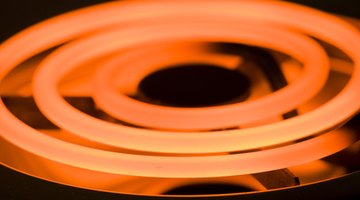Parts of an Electric Stove
Table of Contents
Electric stoves are the main alternative to conventional gas stoves. They offer a means of cooking using electricity to produce heat. Electric ranges and ovens are available separately or in a combined package for versatility and space-savings in the kitchen.

Electric stoves use several parts to provide clean, consistent cooking heat.
Heating Elements
Some of the most important parts of an electric stove are the heating elements, which convert electrical energy into heat for cooking. An electric range may use one of a number of different heating element styles, including traditional coil elements, metal disks, hidden radiant heating elements below the range surface or magnetic induction elements.
Electric ovens generally feature two heating elements. One is located near the top of the oven for broiling or heating food from above. The other is located near the base of the oven and supplies heat for baking. Cooks can activate one or both heating elements, depending on cooking needs.
Thermostat
An electric stove's thermostat is a simple device that monitors the temperature inside the oven and disengages or engages the heating elements as necessary. The thermostat is connected to the control knobs and may also supply a digital read-out of the desired temperature or activate a light when the oven is heated to the desired level.
Fuses
Electric stoves use a series of fuses to protect the heating elements. These fuses will blow if too much electricity flows through them, preventing the surge from reaching the heating elements. Electric stove fuses are generally located in a closed fuse box near the base of the oven or behind the stove assembly.
Racks
Electric stoves use conventional oven racks as the cooking surface within the oven. Instead of a separate compartment for broiling, as some gas ovens have, electric stoves require the cook to raise one of the oven racks to a higher position to place the food directly below the upper heating element.
Control Knobs
An electric stove's control knobs give the user a way of setting the temperature of the oven and activating each of the burners on the range individually. The knobs also control the oven's self-cleaning feature and set the timer.
Timer
Electric stoves usually include a digital or mechanical timer for ensuring that food stays in the oven for the proper amount of time. The timer may be linked to a clock or separate from it. Some electric stoves also include a self-timer for setting the oven to turn on or off at a specified time. Other timers simply buzz or beep when they reach the desired time, alerting the user that it's time to check the food or add ingredients.
The Drip Cap
- Electric stoves are the main alternative to conventional gas stoves.
- They offer a means of cooking using electricity to produce heat.
- Electric stoves use several parts to provide clean, consistent cooking heat.
- One is located near the top of the oven for broiling or heating food from above.
- An electric stove's thermostat is a simple device that monitors the temperature inside the oven and disengages or engages the heating elements as necessary.
References
Resources
Photo Credits
- Close-up image of an electric range heating element image by Alexey Stiop from Fotolia.com
- Close-up image of an electric range heating element image by Alexey Stiop from Fotolia.com
More Articles



